Asylum, Prison, and Poorhouse provides the reader with a deeper understanding of social reform, social reformer, and the process as it occurred—or did not occur—in the state of Illinois Analytical linkages to theories of social change such as progressivism or social control are less well developedDorothea Lynde Dix lead the asylum movement in Massachusetts and her efforts quickened the movement in other states Dorothea Dix earned a teaching certificate at the age of fourteen In 1841, she taught a Sunday class at East Cambridge Jail, which was a female prison;Dorothea Dix was an educator and social reformer whose devotion to the welfare of the mentally ill led to widespread international reforms
Antebellum Era Prison And Asylum Reform Stmu History Media
Dorothea dix prison reform
Dorothea dix prison reform-In a time where people were quick to push for reforms such as abolition, temperance, as well as school and prison reforms, Dorothea Dix's relentless push for the reform of the mentally ill's conditions caught right on board Not only did she push for reform in the States, she extended her influence to places like Scotland, her work creating the Scottish Lunacy Commission who Dorothea Dix was a very influential reformer Her work led to prison reform and improved treatment of the insane She helped changed the way mentally ill were treated She left her family at the age of 12 to live with her grandmother At age 14 she founded a school for young children, and taught there for the next two decades
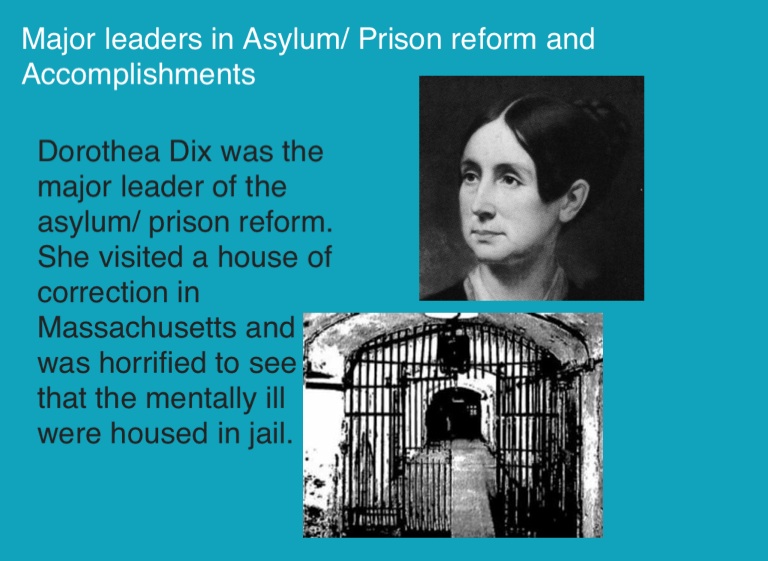



The Age Of Change Reform Movement Of The 10 S Screen 7 On Flowvella Presentation Software For Mac Ipad And Iphone
Dorothea Dix had a huge impact on the Prison Reform in the 1840s Dix went into prisons all over Massachusetts and recorded what she had observed from her visits She witnessed the horrible conditions both prisoners and mentally ill people were kept in Dix believed that the mentally ill and the criminals should be kept separate and the mentally ill should get the treatment they neededA social reformer dedicated to changing conditions for people who could not help themselves, Dorothea Dix was a champion for the mentally ill and the imprisoned Through her tireless work of over two decades, Dix instituted changes in the treatment and care of the mentally ill and improved prison conditions Dix continued to work towards improving the care of the mentally ill, which was her primary focus, as she expanded her efforts to prison reform, which she pursued soon after her work on asylum reform 6 Asylum and Prison reforms, still topics of importance today, have changed drastically from the era of Dorothea Dix's reforms
Dorothea Dix was a pioneer of mental health reform and made important contributions in her field Her tireless dedication improved living conditions and treatment for people with mental illnesses Dorothea Dix () didn't have a very happy childhoodDiscover and share Quotes About Prison Reform Dorothea Dix Explore our collection of motivational and famous quotes by authors you know and love Dorothea Lynde Dix () was an author, teacher and reformer Her efforts on behalf of the mentally ill and prisoners helped create dozens of new institutions across the United States and in
Dorothea Dix believed that prisoners were capable of reform and were worthy of an appropriate amount of respect from society Dix represented the spirit of the Second Great Awakening because during this religious movement, people believed that selfreflection and devotion to religion would allow them to earn salvationShe gave the mentally ill better conditions and a place where there needs are met Essential Question Mental Hospital Dorothea Dix Hospital Mental Hospital and helps with issues 10's and 1840's Raliegh North Carolina Dorothea DixDorothea Dix is known for the start of the Prison and Asylum Reform It started when she visited a prison to teach a class The things she saw in that prison were just horrible and disgusting In the prison she saw children mixed in with adult criminal, and women chained and locked up in cages Basically, the women were being treated like animals
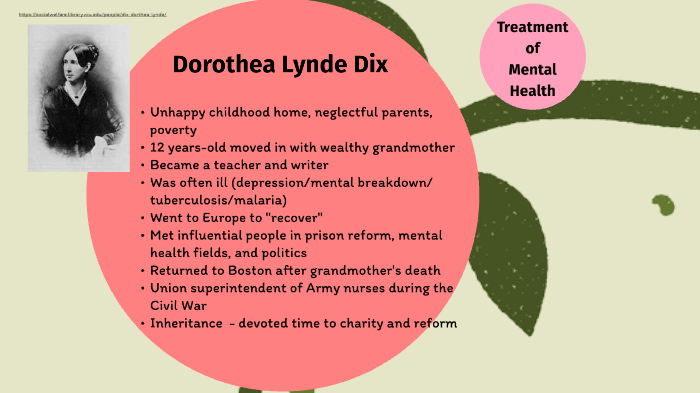



Dorothea Dix By Annie Lupo




Era Of Reform Reasons For Reform Temperance And The Bottle Prison And Asylum Education And Leadership Ppt Download
The attempt to improve conditions inside prisons, establish a more effective penal system, or implement alternatives to incarceration What group of people did Dorothea Dix mainly fight for?Correct answers 2 question Dorothea Dix's Prison Reform Crusade • Do not put debtors in prison • Make sure prisoners have enough food • Do not crowd many prisoners into small spaces • Which choice below best completes this list?This experience served as a catalyst for her reform efforts




Prison And Asylum Reform Ushistory Org




Dorothea Dix S Craze For The Asylum Movement Ppt Download
Dorothea Dix Prison Reform/Mental Hospitals By Madison Radonis and Montanna Weitzel What Did She Do?What is the prison and asylum reform movement?The Kentucky Historical Society (KHS) was formed in 16 by a group of prominent Kentuckians intent on preserving the history of the Commonwealth We are



Dorothea Dix And Her Contributions Punishment Or Penitence




Dorothea Dix Revolutionizing Asylums Youtube
Summary The prison reform movement was a generally successful movement led by Dorothea Dix in the mid1800's This movement sought to reform the poor conditions of prisons and establish separate hospitals for the mentally insaneWho was Dorothea Dix, and how did she contribute to the prison reform movement in the early 1800s? Dorothea Dix was a very influential reformer Her work led to prison reform and improved treatment of the insane She helped changed the way mentally ill were treated She left her family at the age of 12 to live with her grandmother At age 14 she founded a school for young children, and taught there for the next two decades




Dorothea Dix S Tireless Fight To End Inhumane Treatment For Mental Health Patients Pbs Newshour




Prison Reform En Prison Reform Glogster Edu Interactive Multimedia Posters
Dorothea Dix and Insane Asylum/Prison Reform Jacob Bretz, 09 Summer Institute Lesson Plan Abstract The following lesson plan will deal with the efforts of Dorothea Dix in the early to mid 1800s to reform the treatment of mental patients in the United StatesA Allow prisoners to vote B Remove the mentally ill from prisons C Offer every prisoner a basic education D Require prisoners to attend churchHelped establish 12 million acres of land for mentally ill, blind and deaf, adding additions to hospitals, recommended reforms in many countries, helped make a new Hosptial for the mentally ill in Europe, nurse in the civil war;




Prison Reform




Quotes About Prison Reform Dorothea Dix Quotesgram
The champion of discipline and first national figure in prison reform was Louis Dwight founder of the Boston Prison Discipline Society, he spread the Auburn system throughout America's jails and added salvation and Sabbath School to further penitence After several bad starts, America finally enjoyed about a decade of real reformDuring the early nineteenth century, reformers like Dorothea Dix worked to make prisons more humaneDix, Dorothea Lynde (04 April 1802–17 July 17), social reformer, was born in Hampden, Maine (on the Penobscot River), the daughter of Joseph Dix, a minister, and Mary BigelowDuring her early years Dorothea shared a small cottage with her parents and two younger brothers Because her family was quite poor, she often traveled to Boston to live with her grandparents




New Lesson Reforming America With Dix And Mann Emerging America




The Second Great Awakening 19 Th Century Reform
In 1841 Dorthea Dix started the prison and asylum reform movement Her goal was to change the horrible way people were treated in prisons in the mid 1900s During her time trying to reform these places she was met with many obstaclesMass communications Law Education Activists Criticism and interpretation Political activists Prison reform Analysis Reformers Rehabilitation Rhetoric Social reformers Dorothea Dix helped improve the US prison system which led to the creation of hospitals for the mentally ill How did the reforms advocated by people like Dorothea Dix affect life in the United States?




Social Welfare History Project Dix Dorthea Lynde



Prison And Asylum Reform Reform Movements
Dorothea Dix's Prison Reform Crusade • Do not put debtors in prison • Make sure prisoners have enough food • Do not crowd many prisoners into small spaces • Which choice below best completes this list?Dorothea Dix Prison Reform, Accomplishments & Facts Biography wwwbiographycom › activist › dorotheadix Cached;In January, 1843, Dix submitting to the Massachusetts legislature a detailed report on her investigations Her ideas influenced the reform of the Worcester Insane Asylum Her book, Remarks on Prisons and Prison Discipline in the United States was published in 1845 By 1854 Dix had helped to establish mental hospitals in eleven states
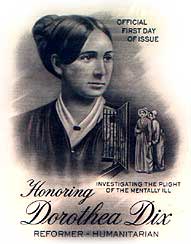



Prison And Asylum Reform Ushistory Org




Dorothea Dix Biography And Accomplishments Study Com
She helped the mentally ill by working towards reform in the treatment of mentally ill patientsShe was a teacher, author, and a social reformer She helped form new establishments for the mentally ill and prisoners in the United States and Europe She was a supporter of theBefore the Civil War, Dix had been trying to improve care for the mentally




Dorothea Dix Redefining Mental Illness




Meet Dorothea Dix The Mother Of Health Care Reform
Historians believe that Dorothea Dix suffered from depression and experienced a mental breakdown during this period spiking her interest in reform for the mentally ill In 16 she traveled to Europe to recover and there met several contemporary reformers including William Rathbone, prison reformer Elizabeth Fry, and the founder of the York Retreat for the mentally ill, Samuel Tuke Dorothea Dix's Prison Reform Crusade • Do not put debtors in prison • Make sure prisoners have enough food • Do not crowd many prisoners into small spaces • Which choice below best completes this list?Dorothea Dix was a social reformer whose devotion to the welfare of the mentally ill led to widespread international reforms




Dorothea Dix Reformer Author Teacher Nurse American Battlefield Trust




Social Reform Mental Illness And Prisons
Prof Allison discusses mental illness, as well as the life and accomplishments of Dorothea Dix, a teacher and mental health reformer Prison reform is the attempt to improve conditions inside prisons, improve the effectiveness of a penal system, or implement alternatives to incarceration It also focuses on ensuring the reinstatement of those whose lives are impacted by crimes In modern times the idea of making living spaces safe and clean has spread from the civilian population to include prisons,What did Dorothea Dix do to help prisoners?



Journals Tulane Edu Ncs Article View 1143 1038




Reform Movements In America Idca
Dorothea Lynde Dix was an American advocate on behalf of the indigent mentally ill who, through a vigorous and sustained program of lobbying state legislatures and the United States Congress, created the first generation of American mental asylums During the Civil War, she served as a Superintendent of Army Nurses Dorothea Dix, the American Advocate, activist, and reformer, redefined the perception of mental health in the United States during the American Civil War Dorothea Dix is best known for her role as the superintendent of female nurses; Who Was Dorothea Dix?



Dorothea Dix History And Heritagetrans Allegheny Lunatic Asylum
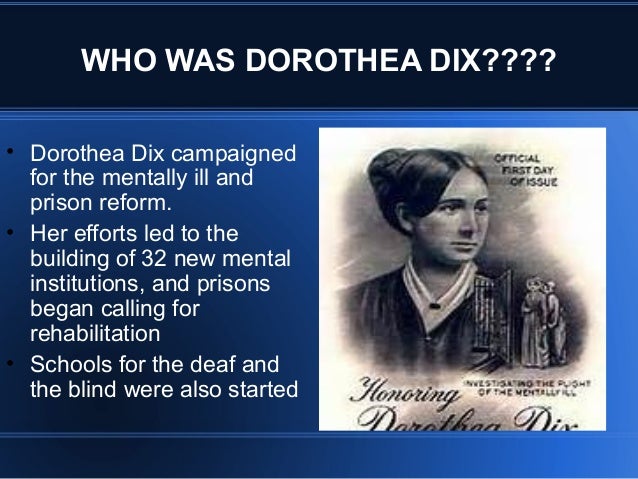



Reform Movement
Led movement to reform prison system;Dorothea Dix Essay 1306 Words 6 Pages Dorothea Dix – One of the Great Women of the 1800s Once in a while a truly exceptional person has made a mark on the growth of mankind Dorothea Dix was an exceptional woman She wrote children's books, she was a school teacher, and she helped reform in prisonsTried to remove mentally ill, runaway children, and orphans from prison Furthermore, what did Dorothea Dix do before the Civil War?



Melvin Zarghooni Estevan Villagrana U S History Projects By John Adams Infographic
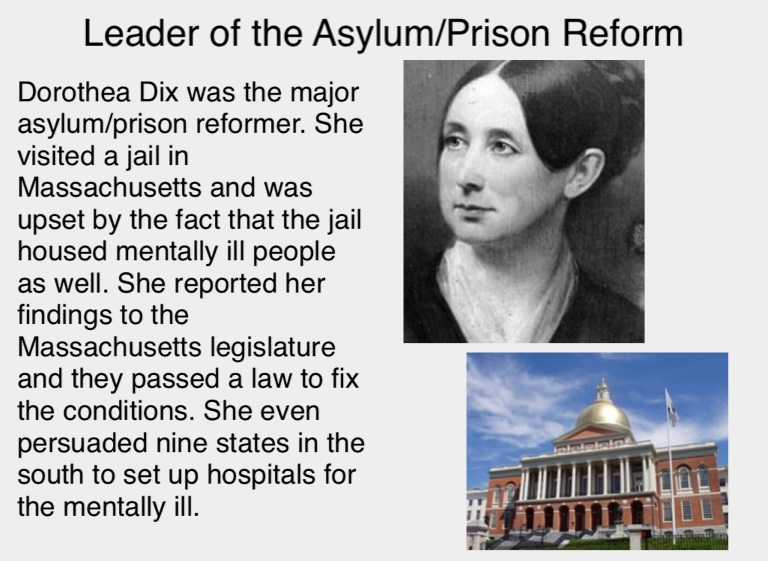



The Age Of Change Reform Movements Of The 10 S Screen 7 On Flowvella Presentation Software For Mac Ipad And Iphone
The reformers change the treatment of the mentally ill and prisoners by Dorothea Dix , in her efforts on behalf of the mentally ill emphasized the idea of rehabilitation, treatment that might reform the sick or imprisoned person to a useful position in societySetting up field hospitals, first aid stations, recruited nurses, managed supplies and setting up training programs,A Allow prisoners to vote B Remove the mentally ill from prisons C Offer every prisoner a basic education




Dorothea Dix The Compassionate Crusader Who Revolutionized Care For The Mentally Ill A Mighty Girl




Dorothea Dix American Social Reformer Britannica
A Allow prisoners to vote B Remove the mentally ill from prisons C Offer every prisoner a basic educationDix () found her commitment to reform not in evangelical Christianity and the revival but in their antithesis, Unitarianism Her father, an abusive alcoholic, was a Methodist itinerant preacher Her stern paternal grandmother, with whom Dix and her siblings went to live when she was a teenager, pushed her into the Congregational Church Why is Dorothea Dix important to people today?




Prison And Asylum Reform Ushistory Org




Top 17 Quotes By Dorothea Dix A Z Quotes
This essay analyzes the humanitarian activist Dorothea Dix's writings on prisons in the 1840s to unpack her rhetoric of rehabilitation, a rhetorical strategy that underpinned the discourse and arguments surrounding criminal punishment for many decades following the rise of the prison in the early nineteenth century Free Online Library A rhetoric of rehabilitation Dorothea Dix's prison reform arguments(Critical essay) by "Argumentation and Advocacy";




Top 17 Quotes By Dorothea Dix A Z Quotes
:max_bytes(150000):strip_icc()/Dorothea-Dix-GettyImages-3094835-56ae97e15f9b58b7d01128c0.jpg)



Dorothea Dix Quotes




9 Best Asylum And Prison Reform Ideas Prison Reform Asylum Prison




Dorothea Dix Hospital Historical Marker Clio




Dorothea Dix And The Trade In Lunacy Psychology Today United Kingdom




The Age Of Change Reform Movement Of The 10 S Screen 7 On Flowvella Presentation Software For Mac Ipad And Iphone




Asylum Prison And Poorhouse The Writings And Reform Work Of Dorothea Dix In Illinois Lightner David L Amazon Com Books




Prison Reform Dorothea Dix The Era Of Reform




A Legacy Of Reform Dorothea Dix 1802 17 States Of Incarceration




Dorothea Dix Prison And Asylum Reform And Reconstruction Studies In Feminist Activism




Dorothea Lynde Dix History




Dorthea Dix Nursing Quotes Quotesgram



Antebellum Era Prison And Asylum Reform Stmu History Media




Dorothea Dix Apush Unit 4




Dix Dorothea Lynde Famous For Reforms Of Prisons And Insane News Photo Getty Images




Dorthea Dix And Prison Reform In The U S Youtube




Dorothea Dix National Postal Museum




Dorothea Dix By Joshua Easter Ppt Download




Social Reform Mental Illness And Prisons




Dorothea Dix S Advocacy For The Mentally Ill In North Carolina



Key Leaders The Prison And Asylum Reform



Dorothea Dix Rights Of The Mentally Ill Lessons Blendspace




Insane Asylum Reform Movement Timeline Timetoast Timelines




Quotes About Prison Reform Dorothea Dix Quotesgram




Dorothea Dix Mental Health Reformer And Civil War Nurse Smithsonian Institution Archives
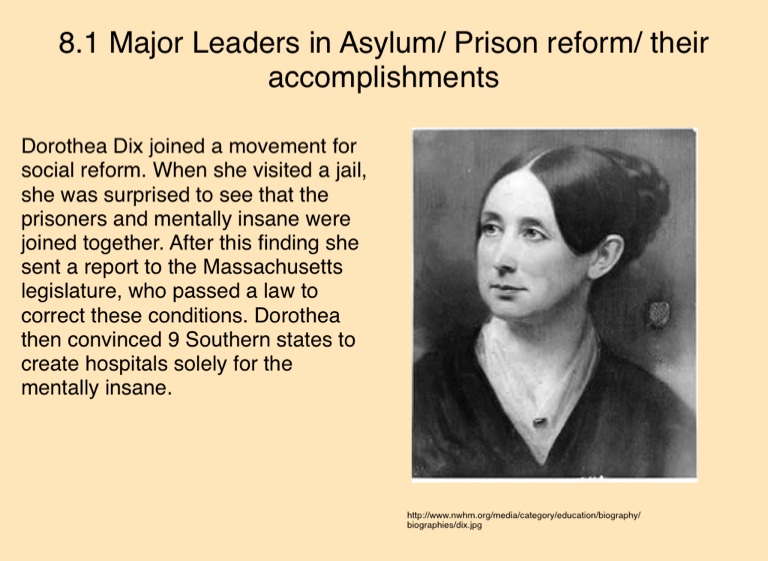



The Age Of Change Reform Movements Of The 10 S Screen 6 On Flowvella Presentation Software For Mac Ipad And Iphone




Asylum Prison And Poorhouse The Writings And Reform Work Of Dorothea Dix In Illinois Lightner David L Amazon Com Books




Dorothea Dix Mental Health Prison Reform Nurse Postcard Zazzle Com




Dorothea Dix Begins Her Crusade




1800s Prison Reform In The Us Tanner Kunaal Youtube




Biography Of Dorothea Lynde Dix




18 3 Prison Reform Reform Movements 1st Hour




Women S History Month 9 In A Series Dorothea Dix Rosanne Welch Ph D




Prison Reform Dix Dorothea Prison Reform Glogster Edu Interactive Multimedia Posters



Q Tbn And9gcqoxlvmzc5nqns52b3wjtpighk0qi3wkqdsrztqe85nqgb2pz Usqp Cau




Dorothea Dix History Of American Women




Dorothea Dix S Craze For The Asylum Movement Ppt Download




Dorothea Dix America Dix Dorothea Eng History Hospital Mental Reformer Social Welfear Glogster Edu Interactive Multimedia Posters




A Portrait Of Dorothea Dix An Advocate For The Indigent Insane Who Helped Establish The Us S First Mental Asylums Dpla




Biography Of Dorothea Lynde Dix



Prison Reform Storyboard By 6259ffa0




Prison Reform By H



Dorothea Dix Prison And Asylum Reform And Reconstruction Studies In Feminist Activism




Dorothea Dix Mentally Ill Activist Apush Youtube




Top 17 Quotes By Dorothea Dix A Z Quotes




Dorothea Dix And The Trade In Lunacy Psychology Today United Kingdom




Social Reform Mental Illness And Prisons




Dorothea Dix Wikipedia




Dorothea Lynde Dix Early Champion Of Better Care For The Mentally Ill Wednesdayswomen



1




Dorothea Dix By Joshua Easter Ppt Download




Top 17 Quotes By Dorothea Dix A Z Quotes




Dorothea Lynde Dix History




Mental Health Homelessness Part 2 San Rafael



1




Dorothea Dix Wikipedia




Dorothea Dix Begins Her Crusade



Dorothea Dix Early 1800s Reforms 2nd Period




Quotes About Prison Reform Dorothea Dix Quotesgram




Reform Movements Of The 1800 S N O




Dorothea Lynde Dix 1845 Boston Athenaeum



Dorothea Dix An Early Champion For The Mentally Ill The State Museum Of Pennsylvania



3




Dorothea Dix Wikipedia




Dorothea Dix Prison And Asylum Reform And Reconstruction Studies In Feminist Activism




Dorothea Dix Prison Reform Accomplishments Facts Biography




Dorothea Dix The Face Of The Mental Health Reform Youtube




Dorothea Dix Reformer Author Teacher Nurse American Battlefield Trust




Quotes About Prison Reform Quotesgram




The Age Of Change Reform Movement Of The 10 S Screen 7 On Flowvella Presentation Software For Mac Ipad And Iphone




Dorothea Dix Hospital Interactive History Timeline North Carolina Health News
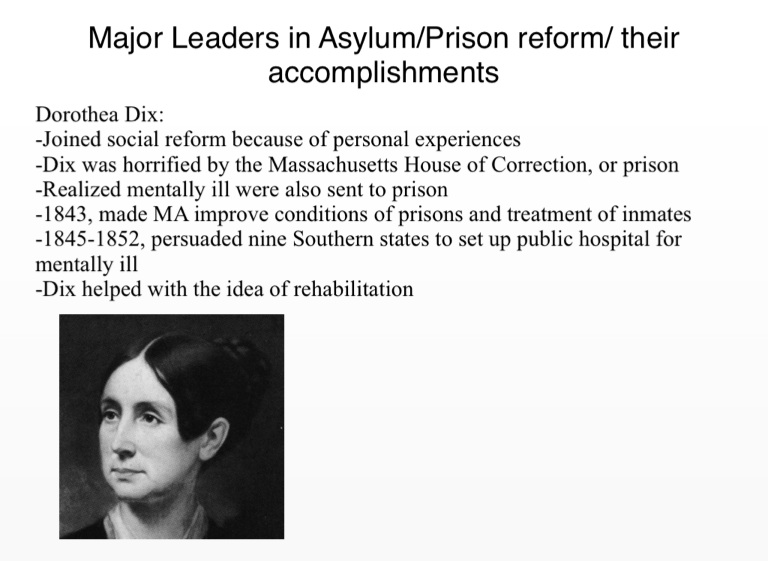



Age Of Reform Soden Alex Screen 7 On Flowvella Presentation Software For Mac Ipad And Iphone




Dorothea Dix Prison Reform Accomplishments Facts Biography




Accomplishments Apush Unit 4



0 件のコメント:
コメントを投稿